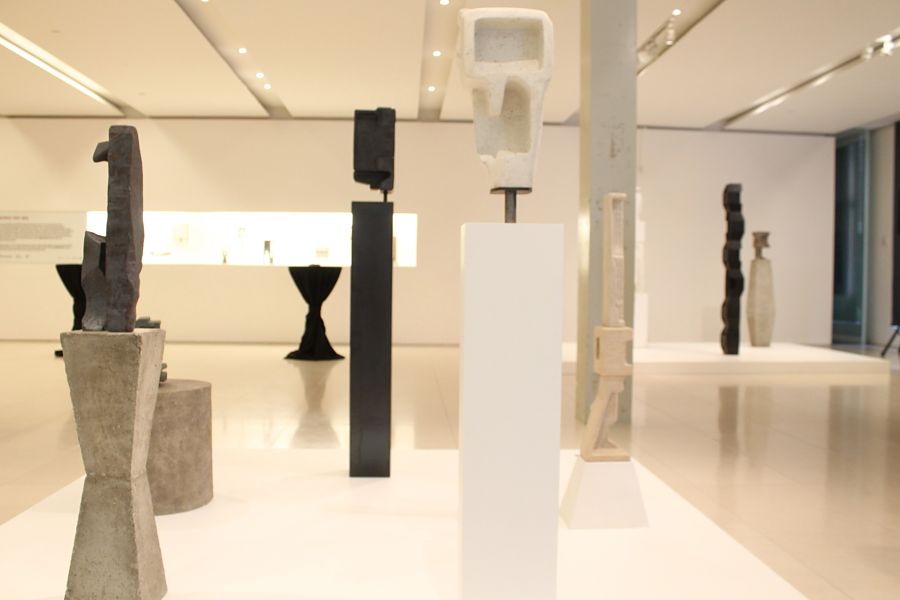 Installation view. Photo: Alice Tallman
Installation view. Photo: Alice Tallman
A contemporary intervention of modernist sculpture by Canadian artist An Te Liu reveal new subjective forms and redefine the spaces that surround them. Mono Ma is an exhibition of new works by An Te Liu for the Gardiner Museum. This is the second in a series of annual exhibitions, which are a part of the museum’s Artist Intervention Program. The Gardiner, Toronto’s ceramics museum, invites artists who work in a diverse range of mediums to present their art at the museum. The sculptural medium is a natural fit for an intervention as sculpture deals directly with the spatial relationship between the object, the viewer and the space. Mono No Ma opened on September 6th, the event brought together patrons, curators, artists and architects to maneuver their way through the crowded space filled with art and viewers.
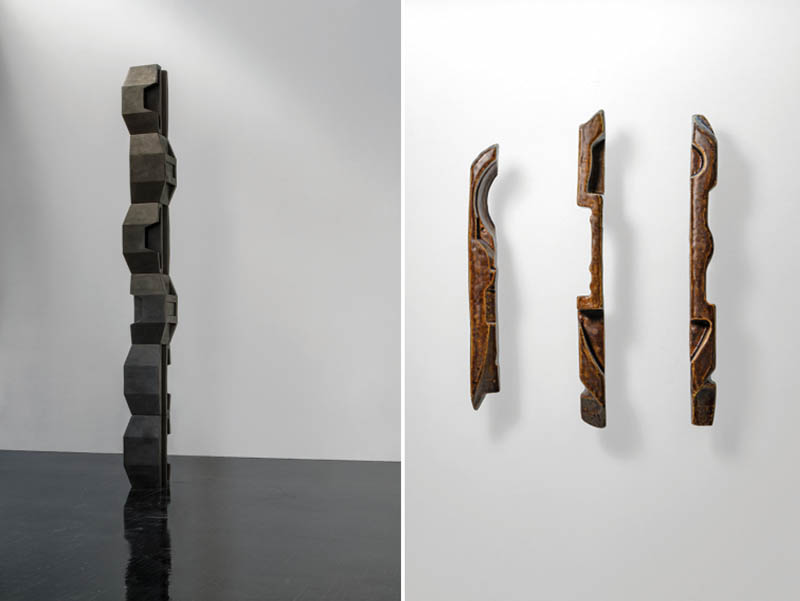 An Te Liu, Gnomon, 2013, Cast plaster with pigmentation, 16 x 183 x 16.3 cm (left); An Te Liu, Mono a Mono, 2013, Slip cast stoneware with iron-based glaze, three parts 2.5 x 28 x 4 cm 2.5 x 33 x 5 cm 2.5 x 33 x 4 cm (right). Courtesy of Gardiner Museum
An Te Liu, Gnomon, 2013, Cast plaster with pigmentation, 16 x 183 x 16.3 cm (left); An Te Liu, Mono a Mono, 2013, Slip cast stoneware with iron-based glaze, three parts 2.5 x 28 x 4 cm 2.5 x 33 x 5 cm 2.5 x 33 x 4 cm (right). Courtesy of Gardiner Museum
These works are divided between two platforms and one glass display case in the lobby of the museum. The sculptures placed on the pedestals are juxtaposed with those placed behind glass, like much of the museum’s permanent ceramic collection.
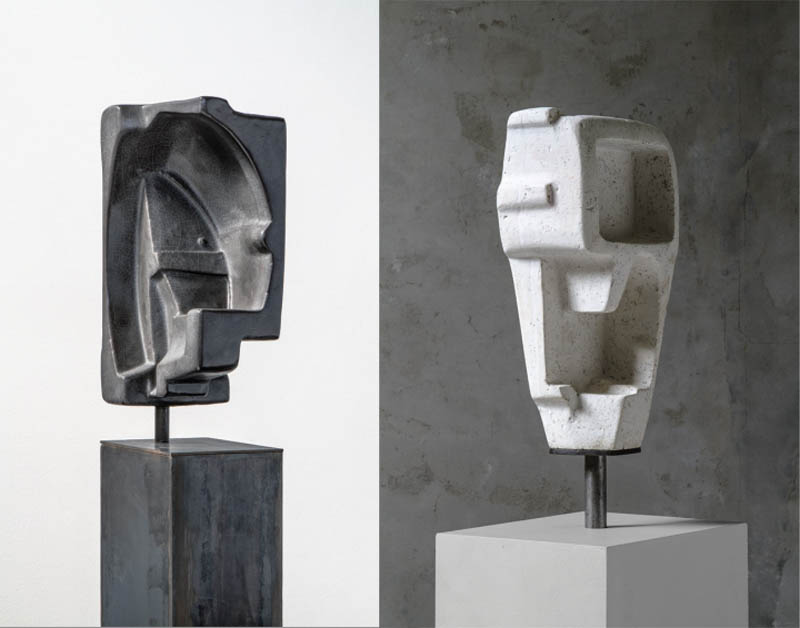 An Te Liu, Maschinenmensch, 2013 Slip cast earthenware with manganese-based glaze 16.5 x 32.5 x 14.5 cm. Steel base 16 x 107 x 13.5 cm (left); An Te Liu, Xoanon, 2013, Press moulded earthenware with sawdust additions and copper oxide slip 20.5 x 38 x 12.5 cm (right). Courtesy of Gardiner Museum.
An Te Liu, Maschinenmensch, 2013 Slip cast earthenware with manganese-based glaze 16.5 x 32.5 x 14.5 cm. Steel base 16 x 107 x 13.5 cm (left); An Te Liu, Xoanon, 2013, Press moulded earthenware with sawdust additions and copper oxide slip 20.5 x 38 x 12.5 cm (right). Courtesy of Gardiner Museum.
An Te Liu, an Associate Professor in the Architecture Department at the University of Toronto, offers up a multiplicity of perspectives in both the scale and the forms of the sculptures. The artist has placed compact forms against elongated totems. The shapes of these works give a sense of depth and solidity ranging from anthromorphic, organic curves to rigid geometrical contours. An Te has created ceramic slip-casts, originally derived from sculpted shapes of styrofoam and other industrial materials. The ceramic cast gives the impression of materials such as marble, bronze and steel. The underlying objects have given these works the appearance of carved and hollowed out forms.
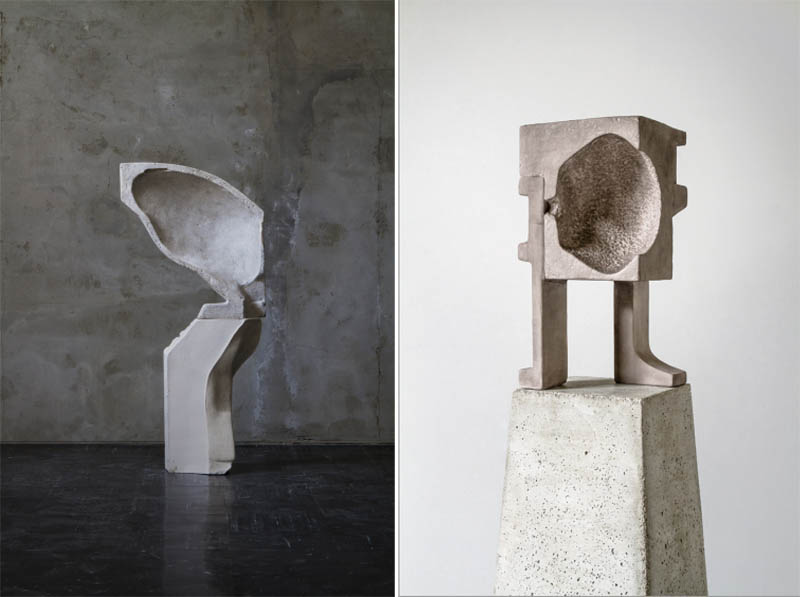 An Te Liu, Aphros, 2013, Press moulded earthenware with sawdust additions, copper oxide slip, and pigmentation 42 x 45 x 13.5 cm, Plaster base 28 x 44.5 x 10 cm (left); An Te Liu, Chimera, 2013. Slip cast earthenware with grey slip and pigmentation 17 x 33.5 x 14.5 cm, Concrete base 27 x 106.5 x 24 cm(right). Courtesy of Gardiner Museum
An Te Liu, Aphros, 2013, Press moulded earthenware with sawdust additions, copper oxide slip, and pigmentation 42 x 45 x 13.5 cm, Plaster base 28 x 44.5 x 10 cm (left); An Te Liu, Chimera, 2013. Slip cast earthenware with grey slip and pigmentation 17 x 33.5 x 14.5 cm, Concrete base 27 x 106.5 x 24 cm(right). Courtesy of Gardiner Museum
There is ambivalence in both the material and function of these sculptures. Although An Te has used industrial objects to create these works, they bare little resemblance to the human forms that are alluded to in their titles. An Te has created his own lexicon through his selection of found materials, melding together the ancient and the modern. Some of the titles of works such as Lacuna and Chimera make reference to ancient history and language while their forms reflect the modernist legacy of sculpture and painting. This juxtaposing of objects made of industrial materials with titles referencing figures in some cases from antiquity, illustrates the endless possibilities of reworking materials and reframing their narratives within space.
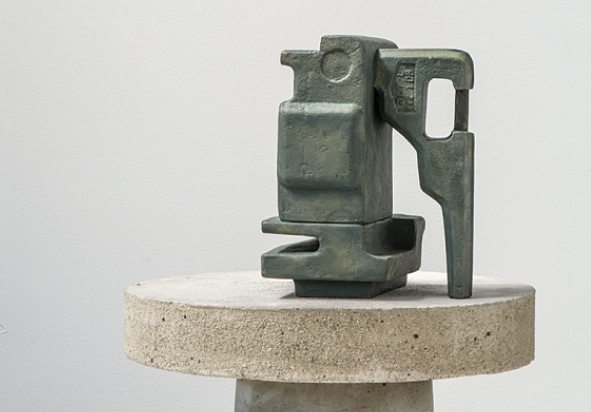 An Te Liu, George, 2013, Slip cast earthenware 15 x 24 x 18 cm, Two part concrete base 38 x 14 cm. Courtesy of Gardiner Museum
An Te Liu, George, 2013, Slip cast earthenware 15 x 24 x 18 cm, Two part concrete base 38 x 14 cm. Courtesy of Gardiner Museum
It is this unlikely pairing of objects and titles that delights and challenges the viewer to rethink their expectations of what they see. Similar challenges have been presented by artists since Duchamp’s Fountain and to this day continue to provoke.
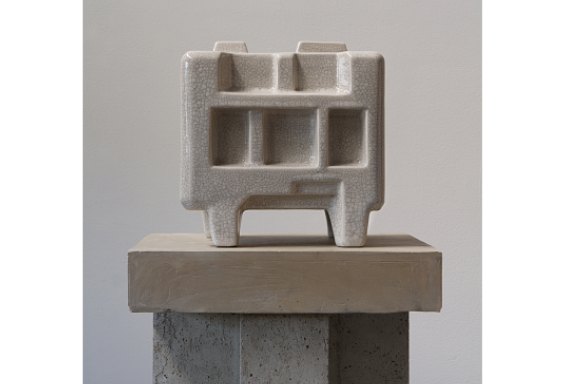 An Te Liu, Brutalist Rice Cooker, 2013, Slip cast stoneware with overglaze pigmentation 20.5 x 19 x 20.5 cm. Courtesy of Gardiner Museum
An Te Liu, Brutalist Rice Cooker, 2013, Slip cast stoneware with overglaze pigmentation 20.5 x 19 x 20.5 cm. Courtesy of Gardiner Museum
An Te Liu’s show is well worth the visit and is on until November 11, 2013.
Alice Tallman
